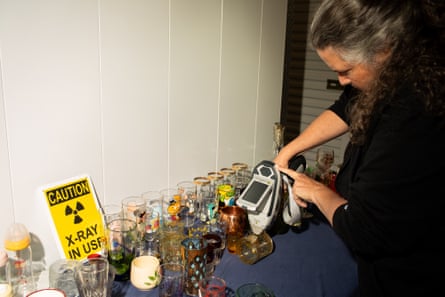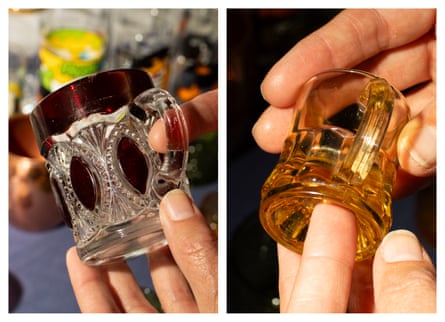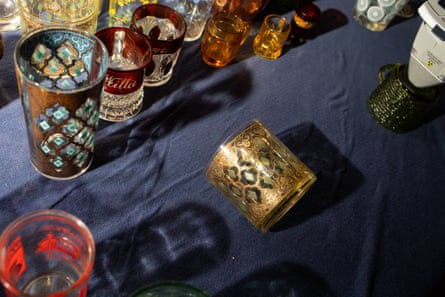Deadly drinkware: a vintage lover’s guide to not getting lead poisoning
I love vintage barware. I love scouring the shelves of thrift stores for green martini glasses with wobbly stems and cups with little strawberries painted on them. I love the way these things look on my bar cart and how they feel in my hand. I love that they are stylish, affordable and eco-friendly. But I would absolutely hate to get lead poisoning from them, and unfortunately some of these household items can pose that risk.
Before U.S. regulations were introduced in the mid-1970s, manufacturers often added lead, and to a lesser extent the carcinogens cadmium and arsenic, to ceramic glazes, painted barware and crystal glassware to improve their appearance or durability. As a result, some vintage items contain toxic substances, making them a potential source of lead poisoning.
“Vintage barware can contain enough contaminants to cause biological harm to people,” says Tamara Rubin, an Oregon-based lead poisoning prevention advocate.
Repeated exposure to lead and cadmium can cause it to build up in our skin bones And kidneys which respectively contribute to a wide range of health outcomes including reduced bone density, neurological problems, low sperm count, mood disorders, joint pain and heart disease. (Other common sources of lead include house paint manufactured before 1978 and soil, which may be contaminated by leaded fuel.) In the U.S., an estimated 410,000 people die prematurely each year from complications related to lead poisoning.
So, what’s a vintage lover to do? This is what experts suggest.
Look after
Occasionally coming into contact with a small amount of lead may not seem alarming, but the cumulative effects of even low levels of exposure can lead to health problems. “If you can avoid the exposure, why not?” advises Dr. Nicholas Newman, a researcher and physician specializing in lead poisoning at Cincinnati Children’s Hospital Medical Center. This caution is especially relevant for households with children, who are small and put everything in their mouths, or for pregnant people, who are particularly vulnerable to lead. It is wise to treat vintage barware that you suspect may contain lead as decorative rather than functional.
Rate your items (or ask an expert to do it for you)
Unfortunately, it is difficult to determine whether an item contains lead without the aid of a specialized consumer product testing laboratory – this can be difficult given most of the focus on paint and soil testing – or expensive professional services. Although DIY test sticks can be found at hardware stores, they are not specifically designed for consumer items, which could potentially lead to unreliable results.

An advanced laboratory-grade device known as an X-ray fluorescence spectrometer (or XRF machine) provides much more accurate measurements of the elements in a given object. These machines are expensive and require training to use, but Rubin uses one to test products for her website, Lead Safe Mama. She has built up an extensive archive of test results of popular vintage items, such as floral glassware, milk glass And illustrated mugs, and accepts donated items for testing. In 2019, Rubin posted about discovering a piece of her own inherited vintage barware pieces contain a shocking 90,000 parts per million (ppm) of lead and more than 2,000 ppm of cadmium; For perspective, the Consumer Product Safety Commission’s threshold for lead in surface coatings of consumer products is 90 ppm, and the EU limits the presence of cadmium to 75 ppm.
Avoid orange, yellow or red items
As a general guideline, you should be wary of orange, yellow or red products as cadmium is often used to obtain these pigments. This care is not limited to very old objects; Cadmium has been found in products from the 1970s Garfield glasses to new McDonald’s cups from 2010. Not every item in these colors will contain cadmium, but if you are unsure about a particular item, consider researching its origin or not using it. Place it in a display case or on a shelf, where it poses less risk.

Check items for wear and tear
“I can almost guarantee you that if you have a vintage glass with a painted exterior that feels three-dimensional, rough or protrudes slightly above the glass, it is most likely lead paint,” says Rubin. Worn or scratched paint can barn microparticles of toxins that are too small to see, and which can then end up in your mouth along with a sip of margarita or a handful of tortilla chips. “There’s more wear and tear on the surfaces than you might think,” Newman warns – especially if you run your items through the dishwasher. Be careful not to drink from vintage barrels with raised paint, especially if they have seen better days.
Do not leave liquid in vintage barrels for too long
The risk of lead exposure can increase depending on what you put in a barrel and for how long. Acidic liquids, alcohol and hot liquids can react with lead compounds in paints, glazes and base materials, increasing their solubility and the potential for leaching. Don’t store whiskey in a leaded crystal decanter for long periods (Newman says a few hours here and there is less risky) and don’t drink coffee from a vintage glazed ceramic mug every morning.
Look for solid shades and press line marks
Rubin suggests looking for vintage eyeglasses from the 1920s through the 1940s with a marking called a press line, usually found along the side or handle. This slightly raised seam indicates that the glass has undergone a casting process in which usually no lead has been added. Rubin also notes that in her general experience, unpainted, plain vintage glassware is less likely to contain lead than painted or glazed vessels.

Have a blood test done
Symptoms of lead poisoning may include: subtle; If you are concerned that you may have been exposed, ask your doctor for a blood test. Generally, 5 micrograms of lead per deciliter (about half a cup) of blood is considered elevated in adults. (There is no safe lead blood level for children). Someone at that level would likely be told to identify the likely source of the lead, then stop using it and get a follow-up panel, Newman says. Test results showing more than 40 micrograms of lead per deciliter, especially in a person exhibiting noticeable symptoms such as problems with balance or walking, require immediate medical attention.
